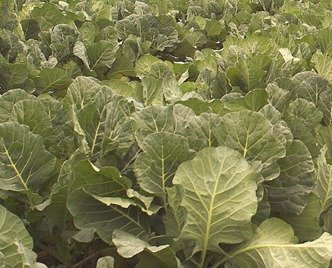Growing Collard Greens
Organic Vegetable Gardening
Fact Sheet
Botanical name: Brassica oleracea var. acephala
Seed |
|
||
| Planting time: | SP,FA | ||
| Seeds per ounce: | 9000 | ||
| Ounces per square foot: | 0.0001 | ||
| Minimum legal germination rate: | 80% | ||
| Germination type: | Short Germinating seeds | ||
Notes Today collards are grown throughout North America. In the north, you can plant collards in the early spring, and harvest them all summer, fall, or early winter. In warmer areas collards will survive the winter, and you can harvest year round. Collard Greens is in the Brassica genus as well as Broccoli, Cabbage and Brussels Sprouts. |
|||
Planting |
|||
| In garden spacing (inches): | 12 | ||
| In flat spacing (inches): | 1 | ||
| Planting depth (inches): | cover seed with soil | ||
| Maximum number of plants per square foot: | .8 | ||
| Nutrient relationship: | Heavy Feeder | ||
Harvest |
|||
| Days to maturity: | 84 | ||
| Harvesting period (days): | 168 | ||
| Minimum yields in pounds /square foot: | 1.6 | ||
Cultural |
|
| Diseases: | Pythium Damping-Off - This disease commonly affects seeds and young transplants and is caused by the soil-borne fungus. Downy Mildew - This disease is caused by the fungus Peronospora parasitica and can attack both seedlings and mature vegetable plants. Alternaria Leaf Spot - This disease is caused by the fungus, Alternaria species, and occurs during warm, moist conditions. Black Rot - Black rot is caused by a bacterium, Xanthomonas campestris pathovar campestris, and can affect all vegetables in the crucifer family. Black Leg - The fungus, Phoma lingam, causes black leg. Wirestem - The fungus, Rhizoctonia solani, causes wirestem. Fusarium Yellows - Yellows or wilt is a much less important disease today due to the development of varieties resistant to the disease. Viruses - There are several common viruses that can affect cole crops including Turnip mosaic virus and Collard Greens mosaic virus.. |
| Insect pests:(Insect Pest Finder) | Army Cutworm, Bean Aphid, Collard Greens Curculio, Collard Greens Looper, Collard Greens Maggot, Cutworm, Flea Beetle, Garden Centipede, Green Peach Aphid, Pea Aphid, Spotted Cucumber Beetle |
Varieties for Growing Collard Greens |
|
| Georgia Southern - Tolerates cool weather well. The plants produce large open heads of thick blue-green flavorful leaves. It's rich in vitamins and excellent for cooking or freezing. | |
| Morris Heading - Produces broad, waxy leaves that vary from green to blue-green. Many plants will form loose, leafy heads late in the growing season. An old Southern favorite with great flavor and nutrition. Leaves are made sweeter by frost. Great for fall. | |
| Vates - This non-heading variety has dark green, slick, crumpled leaves on 30 inch plants, and is bolt and frost resistant. Winter hardy in southern and mid-Atlantic states. | |
Organic Gardening Seed and Plant Sources:
Return to Organic Gardening Vegetables from Growing Collard Greens





Comments
Have your say about what you just read! Leave me a comment in the box below.